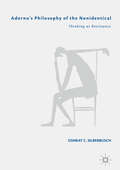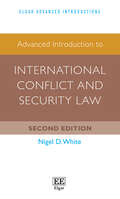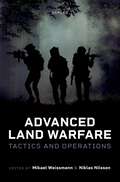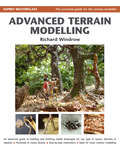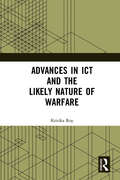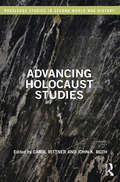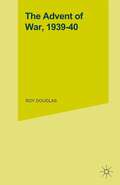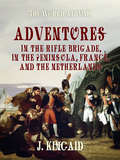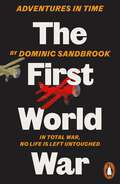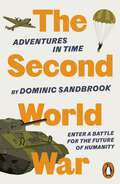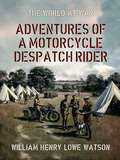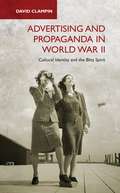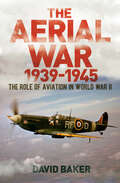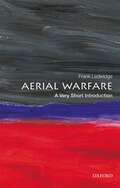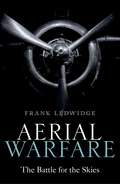- Table View
- List View
'Adolf Island': The Nazi occupation of Alderney
by Caroline Sturdy Colls Kevin Colls‘Adolf Island’ offers new forensic, archaeological and spatial perspectives on the Nazi forced and slave labour programme that was initiated on the Channel Island of Alderney during its occupation in the Second World War. Drawing on extensive archival research and the results of the first in-field investigations of the ‘crime scenes’ since 1945, the book identifies and characterises the network of concentration and labour camps, fortifications, burial sites and other material traces connected to the occupation, providing new insights into the identities and experiences of the men and women who lived, worked and died within this landscape. Moving beyond previous studies focused on military aspects of occupation, the book argues that Alderney was intrinsically linked to wider systems of Nazi forced and slave labour.
'Adolf Island': The Nazi occupation of Alderney
by Caroline Sturdy Colls Kevin Colls‘Adolf Island’ offers new forensic, archaeological and spatial perspectives on the Nazi forced and slave labour programme that was initiated on the Channel Island of Alderney during its occupation in the Second World War. Drawing on extensive archival research and the results of the first in-field investigations of the ‘crime scenes’ since 1945, the book identifies and characterises the network of concentration and labour camps, fortifications, burial sites and other material traces connected to the occupation, providing new insights into the identities and experiences of the men and women who lived, worked and died within this landscape. Moving beyond previous studies focused on military aspects of occupation, the book argues that Alderney was intrinsically linked to wider systems of Nazi forced and slave labour.
Adorno’s Philosophy of the Nonidentical: Thinking as Resistance
by Oshrat C. SilberbuschThis book focuses on a central notion in Theodor. W. Adorno’s philosophy: the nonidentical. The nonidentical is what our conceptual framework cannot grasp and must therefore silence, the unexpressed other of our rational engagement with the world. This study presents the nonidentical as the multidimensional centerpiece of Adorno’s reflections on subjectivity, truth, suffering, history, art, morality and politics, revealing the intimate relationship between how and what we think. Adorno’s work, written in the shadow of Auschwitz, is a quest for a different way of thinking, one that would give the nonidentical a voice – as the somatic in reasoning, the ephemeral in truth, the aesthetic in cognition, the other in society. Adorno’s philosophy of the nonidentical reveals itself not only as a powerful hermeneutics of the past, but also as an important tool for the understanding of modern phenomena such as xenophobia, populism, political polarization, identity politics, and systemic racism.
Advanced Introduction to International Conflict and Security Law (Elgar Advanced Introductions series)
by Nigel D. WhiteElgar Advanced Introductions are stimulating and thoughtful introductions to major fields in the social sciences, business and law, expertly written by the world’s leading scholars. Designed to be accessible yet rigorous, they offer concise and lucid surveys of the substantive and policy issues associated with discrete subject areas.This updated and revised second edition of Advanced Introduction to International Conflict and Security Law provides a concise and insightful guide to the key principles of international law governing peacetime security, arms control, the use of force, armed conflict and post-conflict situations. Nigel D. White explores the complex legal regimes that have been created to control levels of armaments, to limit the occasions when governments can use military force, to mitigate the conduct of warfare and to build peace.Key Features:Analysis of new efforts to regulate nuclear weaponsExtended coverage of peacekeeping and analysis of war crimesUpdated coverage of recent state practice and academic literatureNew analysis of recent and on-going conflicts, in particular Syria and UkraineWith updated analysis of peacekeeping, the law surrounding nuclear weapons, war crimes and extensive coverage of conflicts in Syria and Ukraine, this thoroughly revised second edition is an essential text for academics, researchers and students interested in international law and world peace.
Advanced Land Warfare: Tactics and Operations
by Weissmann MikaelInternational politics have become ever more volatile over the last decade, increasing the risk of large-scale military violence. Yet the precise character of future war will depend on a range of factors that relate to adversaries, allies, technology, geographical scope and multiple domains of warfighting. Few would question that land forces will be important also in the foreseeable future. However, given that the battlefield is in a state of transformation, so is the mission, purpose and utilization of land forces. Indeed, the future conduct of land warfare is subjected to serious and important questions in the face of large and complex challenges and security threats. Advanced Land Warfare explores the evolving role of land forces, paying particular attention to the changes that have taken place in the art of commanding and executing combat, as well as the role of rapid technological innovation and information dissemination in shaping warfare. The book provides insights into key contemporary developments in land warfare and presents case studies on land tactics and operations in different national contexts, drawing on the best of theory, practice, and professional experience and featuring chapters written by leading international scholars and practitioners. Relating to the realities of the modern battlefield, the book addresses a number of critical questions about land tactics and operations, combining a conceptual basis with empirical examples of tactical thinking and practice and emphasising the importance of understanding the perspectives of various national armies, in order to provide a current understanding of the central issues of land warfare. An open access title available under the terms of a CC BY-NC-ND 4.0 International licence.
Advanced Land Warfare: Tactics and Operations
International politics have become ever more volatile over the last decade, increasing the risk of large-scale military violence. Yet the precise character of future war will depend on a range of factors that relate to adversaries, allies, technology, geographical scope and multiple domains of warfighting. Few would question that land forces will be important also in the foreseeable future. However, given that the battlefield is in a state of transformation, so is the mission, purpose and utilization of land forces. Indeed, the future conduct of land warfare is subjected to serious and important questions in the face of large and complex challenges and security threats. Advanced Land Warfare explores the evolving role of land forces, paying particular attention to the changes that have taken place in the art of commanding and executing combat, as well as the role of rapid technological innovation and information dissemination in shaping warfare. The book provides insights into key contemporary developments in land warfare and presents case studies on land tactics and operations in different national contexts, drawing on the best of theory, practice, and professional experience and featuring chapters written by leading international scholars and practitioners. Relating to the realities of the modern battlefield, the book addresses a number of critical questions about land tactics and operations, combining a conceptual basis with empirical examples of tactical thinking and practice and emphasising the importance of understanding the perspectives of various national armies, in order to provide a current understanding of the central issues of land warfare. An open access title available under the terms of a CC BY-NC-ND 4.0 International licence.
Advanced Terrain Modelling
by Richard WindrowThe secrets of terrain modelling are revealed by Richard Windrow, one of the world's leading modellers. Everything from castles to the destruction wrought upon modern cities by war is covered in this accessible book. Explore the difficulties of creating a desert landscape, from the sandstone of Arizona to the wastelands of North Africa. Discover the handiwork needed to create the barbed wire death traps of No-Man's Land and the wilderness of Russia in winter. The variety of seasons, environments and historical periods are detailed in over 200 step-by-step photographs answering a modeller's 'how to' questions. Accompanying these photographs is an invaluable guide to the materials and techniques needed to create top-quality terrain, providing the essential reference volume for the military and non-military modeller alike.
Advanced Terrain Modelling
by Richard WindrowThe secrets of terrain modelling are revealed by Richard Windrow, one of the world's leading modellers. Everything from castles to the destruction wrought upon modern cities by war is covered in this accessible book. Explore the difficulties of creating a desert landscape, from the sandstone of Arizona to the wastelands of North Africa. Discover the handiwork needed to create the barbed wire death traps of No-Man's Land and the wilderness of Russia in winter. The variety of seasons, environments and historical periods are detailed in over 200 step-by-step photographs answering a modeller's 'how to' questions. Accompanying these photographs is an invaluable guide to the materials and techniques needed to create top-quality terrain, providing the essential reference volume for the military and non-military modeller alike.
Advances in ICT and the Likely Nature of Warfare
by Kritika RoyThis book focuses on how advances in ICT have brought about a sea change in the way people work, live and share while also making them vulnerable. These advances exhibit a fundamentally reformed global context for development that has not just been restricted to the civilian domain but has simultaneously impacted the military domain. The exponential pace of advances in the field of Artificial Intelligence (AI), robotics, big data, quantum computing or IoT (Internet of Things) pioneers a significantly different vision of work and society. The current trends in warfighting present a very blurred picture of the future operating environment, but they give some shape to its likely direction. Military forces are trying to become much more flexible and have been adapting to these changes while emphasizing the importance of innovation and improvisation in order to counter challenges emanating from future scenarios. In this context, the book highlights the changing military strategies and tactics across nations vis-à-vis the hanging and emerging ICT technologies. It also highlights the importance of looking at present institutions, legal frameworks and principles as well as at the restraining factors inherent in realpolitik in order to understand if nation states are ready. Please note: Taylor & Francis does not sell or distribute the Hardback in India, Pakistan, Nepal, Bhutan, Bangladesh and Sri Lanka
Advances in ICT and the Likely Nature of Warfare
by Kritika RoyThis book focuses on how advances in ICT have brought about a sea change in the way people work, live and share while also making them vulnerable. These advances exhibit a fundamentally reformed global context for development that has not just been restricted to the civilian domain but has simultaneously impacted the military domain. The exponential pace of advances in the field of Artificial Intelligence (AI), robotics, big data, quantum computing or IoT (Internet of Things) pioneers a significantly different vision of work and society. The current trends in warfighting present a very blurred picture of the future operating environment, but they give some shape to its likely direction. Military forces are trying to become much more flexible and have been adapting to these changes while emphasizing the importance of innovation and improvisation in order to counter challenges emanating from future scenarios. In this context, the book highlights the changing military strategies and tactics across nations vis-à-vis the hanging and emerging ICT technologies. It also highlights the importance of looking at present institutions, legal frameworks and principles as well as at the restraining factors inherent in realpolitik in order to understand if nation states are ready. Please note: Taylor & Francis does not sell or distribute the Hardback in India, Pakistan, Nepal, Bhutan, Bangladesh and Sri Lanka
Advancing Holocaust Studies (Routledge Studies in Second World War History)
by Carol Rittner John K. RothThe growing field of Holocaust studies confronts a world wracked by antisemitism, immigration and refugee crises, human rights abuses, mass atrocity crimes, threats of nuclear war, the COVID-19 (coronavirus disease 2019) pandemic, and environmental degradation. What does it mean to advance Holocaust studies—what are learning and teaching about the Holocaust for—in such dire straits? Vast resources support study and memorialization of the Holocaust. What assumptions govern that investment? What are its major successes and failures, challenges and prospects? Across thirteen chapters, Advancing Holocaust Studies shows how leading scholars grapple with those tough questions.
Advancing Holocaust Studies (Routledge Studies in Second World War History)
by Carol Rittner John K. RothThe growing field of Holocaust studies confronts a world wracked by antisemitism, immigration and refugee crises, human rights abuses, mass atrocity crimes, threats of nuclear war, the COVID-19 (coronavirus disease 2019) pandemic, and environmental degradation. What does it mean to advance Holocaust studies—what are learning and teaching about the Holocaust for—in such dire straits? Vast resources support study and memorialization of the Holocaust. What assumptions govern that investment? What are its major successes and failures, challenges and prospects? Across thirteen chapters, Advancing Holocaust Studies shows how leading scholars grapple with those tough questions.
The Advent of the All-Volunteer Force: Protecting Free Society (Critical Moments in American History)
by William A. TaylorThis book examines the extensive influence of the All-Volunteer Force (AVF) on the past, present, and future of America, demonstrating how the AVF encompasses the most significant issues of military history and defense policy. Throughout the vast majority of its wars during the twentieth century, the United States relied on a mixture of volunteers who chose to serve and conscripts provided through the Selective Service System, known colloquially as the draft. When the United States emerged as a world superpower in the aftermath of World War II, U.S. policymakers also depended on the draft during peacetime. Drawing on primary source documents, this book guides readers through the transition from the draft to the AVF and analyzes its history, results, challenges, and implications. Each chapter provides an overview of the issues of the time, recounts the ensuing debates and developments around them, and examines how they manifested themselves relative to the advent of the AVF and American society during times of peace and war. Combining narrative with documents, The Advent of the All-Volunteer Force is a valuable resource for students, scholars, policymakers, and general readers interested in modern American history, military history, and the dynamic linkages between policy, politics, and American society.
The Advent of the All-Volunteer Force: Protecting Free Society (Critical Moments in American History)
by William A. TaylorThis book examines the extensive influence of the All-Volunteer Force (AVF) on the past, present, and future of America, demonstrating how the AVF encompasses the most significant issues of military history and defense policy. Throughout the vast majority of its wars during the twentieth century, the United States relied on a mixture of volunteers who chose to serve and conscripts provided through the Selective Service System, known colloquially as the draft. When the United States emerged as a world superpower in the aftermath of World War II, U.S. policymakers also depended on the draft during peacetime. Drawing on primary source documents, this book guides readers through the transition from the draft to the AVF and analyzes its history, results, challenges, and implications. Each chapter provides an overview of the issues of the time, recounts the ensuing debates and developments around them, and examines how they manifested themselves relative to the advent of the AVF and American society during times of peace and war. Combining narrative with documents, The Advent of the All-Volunteer Force is a valuable resource for students, scholars, policymakers, and general readers interested in modern American history, military history, and the dynamic linkages between policy, politics, and American society.
Adventures in the Rifle Brigade, in the Peninsula, France, and the Netherlands (The World At War)
by John KincaidThe memoirs of Capt. J. Kincaid covering his experiences in the famous Rifle Brigade. The Rifle Brigade (Prince Consort's Own) was an infantry rifle regiment of the British Army, formed in 1800 to provide sharpshooters, scouts and skirmishers. They later became part of the Royal Green Jackets. The brigade was distinguished by its use of green uniforms as standard in place of the traditional red, the first regular infantry corps in the British Army to do so.
Adventures in Time: The First World War (Adventures in Time)
by Dominic SandbrookTake a journey to a vanished world with the ADVENTURES IN TIME series - stories so exciting you won't believe they're all true'The whistles blew, the cheers went up, and thousands of men were scrambling up into the rolling fields of No Man's Land . . .'Travel back in time to The First World War, as historian Dominic Sandbrook takes us from the soaring heights of an aeroplane cockpit to the desperate depths of the enemy trenches. We are plunged first hand into a conflict like no other as, amid the greatest clash of empires ever known, the future of the world hangs in the balance... The Adventures in Time series brings the past alive for twenty-first century children. These stories are every bit as exciting as those of Harry Potter or Matilda Wormwood. The only difference is they actually happened...
Adventures in Time: The Second World War (Adventures in Time)
by Dominic SandbrookTake a journey to a vanished world with the ADVENTURES IN TIME* series - stories so exciting you won't believe they're all true'Everything was ready. The air was thick with excitement. This was D-Day...' Prepare to enter the most dramatic conflict the world has ever seen, as historian Dominic Sandbrook takes us on a spine-tingling, heart-stopping adventure. We witness the Second World War first-hand through the eyes of ordinary people living in extraordinary times, from the women who worked all night in factories to the chess players who cracked unbreakable codes. Because in total war, no life is left untouched... The Adventures in Time series brings the past alive for twenty-first century children. These stories are every bit as exciting as those of Harry Potter or Matilda Wormwood. The only difference is they actually happened...*(Perfect for all readers who enjoy tales of heroes, villains, battles, escapes, codebreakers and a secret agent known as the Hedgehog)
Adventures of a Motorcycle Despatch Rider (The World At War)
by William Henry Lowe WatsonCaptain William Henry Lowe Watson (1891-1932) was the British author of Adventures of a Despatch Rider (1915). (Excerpt) "This book is not a history, a military treatise, an essay, or a scrap of autobiography. It has no more accuracy or literary merit than letters usually possess. So I hope you will not judge it too harshly. My only object is to try and show as truthfully as I can the part played in this monstrous war by a despatch rider during the months from August 1914 to February 1915. If that object is gained I am content."
Advertising and Propaganda in World War II: Cultural Identity and the Blitz Spirit (International Library of Twentieth Century History)
by David ClampinThe 'blitz' – the period of Nazi bombing campaigns on civilian Britain during World War II - was a formative period for British national identity. In this groundbreaking book, David Clampin looks at the images, slogans and campaigns which helped to form the fabled 'blitz spirit' – powerfully echoed in Winston Churchill's speeches. Because advertisers attempted to capitalise on war-time patriotism, Clampin's unique focus on advertising provides a visually-rich seam of new information on the everyday war, and makes an enormous contribution to the debate on people's experiences of war and nationalism. Using a remarkable and hitherto unseen range of primary source material - advertisements in the press, slogans and posters - this work will reshape the contested meanings of the 'Home Front', opening up cultural history discourses on gender and nationalism and becoming essential reading for historians of World War II and students and scholars of Media Studies and Communication Studies.
The Aeneid: Selected And Arranged With Brief Notes (classic Reprint) (Collins Classics)
by VirgilHarperCollins is proud to present its incredible range of best-loved, essential classics.
The Aerial War: The Role of Aviation in World War II
by Dr David BakerThe war is a war of machines; it will be won on the assembly line. - Lord Beaverbrook, Minister of Aircraft ProductionJust as vital as the battle on land or the struggle at sea, the air war ultimately tipped the balance of power in World War II. Many campaigns rode on the capabilities of their airforce, as British Spitfires were pitted against Messerschmitt Bf 109s and Japanese Zeros. Aerospace expert David Baker explores this battle in the skies, detailing the technical leaps that were made and little-known histories about the men and women involved, from pilots to factory workers. Featuring magnificent photographs and illustrations, The Aerial War gives a brilliant insight into many key battles and highlights the integral role that aviation played in securing an Allied victory.
Aerial Warfare: The Battle For The Skies (Very Short Introductions)
by Frank LedwidgeAerial warfare has dominated war-making for over 100 years, and despite regular announcements of its demise, it shows no sign of becoming obsolete. In this Very Short Introduction Frank Ledwidge offers a sweeping look at the history of aerial warfare, introducing the major battles, crises, and controversies where air power has taken centre stage, and the changes in technology and air power capabilities over time. Highlighting the role played by air power in the First and Second World Wars, he also sheds light on the lesser-known theatres where the roles of air forces have been clearly decisive in conflicts, in Africa, South America, and Asia. Along the way, Ledwidge asks key questions about the roles air power can deliver, and whether it is conceptually different from other forms of combat. Considering whether bombing has ever been truly effective, he discusses whether wars can be won from the air, and concludes by analysing whether there is a future for manned air power, or if it is inevitable that drones will dominate 21st century war in the air. ABOUT THE SERIES: The Very Short Introductions series from Oxford University Press contains hundreds of titles in almost every subject area. These pocket-sized books are the perfect way to get ahead in a new subject quickly. Our expert authors combine facts, analysis, perspective, new ideas, and enthusiasm to make interesting and challenging topics highly readable. Previously published in hardback as Aerial Warfare: The Battle for the Skies.
Aerial Warfare: The Battle for the Skies
by Frank LedwidgeAerial warfare which has dominated western war-making for over 100 years, and despite regular announcements of its demise, it shows no sign of becoming obsolete. Frank Ledwidge offers a sweeping look at the history of air warfare, introducing the major battles, crises, and controversies where air power has taken centre stage, and the changes in technology and air power capabilities over time. Highlighting the role played by air power in the First and Second World Wars, he also sheds light on the lesser-known theatres where the roles of air forces have been clearly decisive in conflicts, in Africa, South America, and Asia. Along the way, Ledwidge asks key questions about the roles air power can deliver, and whether it is conceptually different from other forms of combat. Considering whether bombing has ever been truly effective, he discusses whether wars can be won from the air, and concludes by analysing whether there is a future for manned air power, or if it is inevitable that drones will dominate 21st century war in the air.
Aerial Warfare: The Battle for the Skies (Very Short Introductions Ser.)
by Frank LedwidgeAerial warfare which has dominated western war-making for over 100 years, and despite regular announcements of its demise, it shows no sign of becoming obsolete. Frank Ledwidge offers a sweeping look at the history of air warfare, introducing the major battles, crises, and controversies where air power has taken centre stage, and the changes in technology and air power capabilities over time. Highlighting the role played by air power in the First and Second World Wars, he also sheds light on the lesser-known theatres where the roles of air forces have been clearly decisive in conflicts, in Africa, South America, and Asia. Along the way, Ledwidge asks key questions about the roles air power can deliver, and whether it is conceptually different from other forms of combat. Considering whether bombing has ever been truly effective, he discusses whether wars can be won from the air, and concludes by analysing whether there is a future for manned air power, or if it is inevitable that drones will dominate 21st century war in the air.

